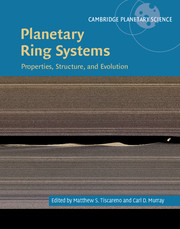Book contents
- Frontmatter
- Contents
- List of Contributors
- Acknowledgements
- I Introductory Material
- II Ring Systems by Location
- III Ring Systems by Type and Topic
- 8 Moonlets in Dense Planetary Rings
- 9 Meteoroid Bombardment and Ballistic Transport in Planetary Rings
- 10 Theory of Narrow Rings and Sharp Edges
- 11 Narrow Rings, Gaps, and Sharp Edges
- 12 Dusty Rings
- 13 The F Ring of Saturn
- 14 Plasma, Neutral Atmosphere, and Energetic Radiation Environments of Planetary Rings
- 15 Thermal Properties of Rings and Ring Particles
- 16 Computer Simulations of Planetary Rings
- 17 Laboratory Studies of Planetary Ring Systems
- 18 The Origin of Planetary Ring Systems
- IV Concluding Material
- Index
- Plate section
- References
17 - Laboratory Studies of Planetary Ring Systems
from III - Ring Systems by Type and Topic
Published online by Cambridge University Press: 26 February 2018
- Frontmatter
- Contents
- List of Contributors
- Acknowledgements
- I Introductory Material
- II Ring Systems by Location
- III Ring Systems by Type and Topic
- 8 Moonlets in Dense Planetary Rings
- 9 Meteoroid Bombardment and Ballistic Transport in Planetary Rings
- 10 Theory of Narrow Rings and Sharp Edges
- 11 Narrow Rings, Gaps, and Sharp Edges
- 12 Dusty Rings
- 13 The F Ring of Saturn
- 14 Plasma, Neutral Atmosphere, and Energetic Radiation Environments of Planetary Rings
- 15 Thermal Properties of Rings and Ring Particles
- 16 Computer Simulations of Planetary Rings
- 17 Laboratory Studies of Planetary Ring Systems
- 18 The Origin of Planetary Ring Systems
- IV Concluding Material
- Index
- Plate section
- References
Summary
INTRODUCTION
The surface area of Saturn's rings is greater than that of any of the planets in the solar system, yet, aside from dust, we have never observed or sampled an individual ring particle. Rings are unique in the solar system in that they are a complex dynamical system whose individual constituents interact not only with the light that we use to sense them remotely, but also with each other through gravitational and contact forces. These dynamical interactions play as large a role in determining the appearance of the ring system as do the optical properties of the individual ring particles. In this chapter we review the experimental work that has been done to help us understand both aspects of planetary rings: their collective dynamical behavior and their optical properties.
We have a wealth of data on the behavior of ensembles of particles, both dynamically and their optical properties. Laboratory measurements of the behavior of various likely ring particle analogs are a critical link in connecting these bulk observations with the nature of individual ring particles, and understanding the properties of individual ring particles should provide clues to the outstanding unanswered questions about the age and origin of rings.
Images of Saturn's rings and optical depth profiles from occultations show features at a variety of spatial scales, from the resolution limit of tens of meters for occultations up to thousands of kilometers, and including most scales in between (Colwell et al., 2009; Chapter 3). A frustratingly small fraction of these structures is well understood. Many that remain puzzling, such as the large optical depth fluctuations in Saturn's central B ring, the complex structure in the B ring and the inner A ring, the long-wavelength low-amplitude undulations in optical depth in the C ring, and the plateaus in the C ring, are likely linked to either the collective behavior of the ring particles governed in part by their collisional properties (see e.g. Schmidt et al., 2009, for a review) or by ballistic transport of material due to extrinsic micrometeoroid bombardment (Chapter 9). The mechanical properties of individual ring particles are critical in both types of process.
- Type
- Chapter
- Information
- Planetary Ring SystemsProperties, Structure, and Evolution, pp. 494 - 516Publisher: Cambridge University PressPrint publication year: 2018
References
- 1
- Cited by



